
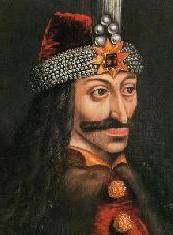 After being a hostage of the Ottomans (1444 -1448) Vlad went to his uncle Iancu de Hunedoara (the ruler of Wallachia), whose daughter Vlad later married, becoming prince of Wallachia on the 22nd of August 1456. Vlad Dracula started organizing the state, the army and the law. He also build several monasteries. He was a respected warrior, ruler and tolerated no crime against his people. In his laws, Vlad applyed the death penalty by impaling to all those he considered enemies (robbers, beggars, etc). Impalement was used also for his war enemyes, the ottomans. Being the one to dare to stand against Mohammed II (the Conqueror), he became known as one of the most feared enemies of the Ottoman empire. His biggest merit is that he succeeded in regaining the country's independence from the Turkish influence. For his people he was a good king, remaining one of the prominent personages of the Romanian history. He was overthrown twice (he ruled for a brief period in 1448 and again between 1456 and 1462). Back to the throne in 1476 with the help of Stefan cel Mare (the ruler of Moldavia), Vlad resumes his fights against the Ottomans. After being a hostage of the Ottomans (1444 -1448) Vlad went to his uncle Iancu de Hunedoara (the ruler of Wallachia), whose daughter Vlad later married, becoming prince of Wallachia on the 22nd of August 1456. Vlad Dracula started organizing the state, the army and the law. He also build several monasteries. He was a respected warrior, ruler and tolerated no crime against his people. In his laws, Vlad applyed the death penalty by impaling to all those he considered enemies (robbers, beggars, etc). Impalement was used also for his war enemyes, the ottomans. Being the one to dare to stand against Mohammed II (the Conqueror), he became known as one of the most feared enemies of the Ottoman empire. His biggest merit is that he succeeded in regaining the country's independence from the Turkish influence. For his people he was a good king, remaining one of the prominent personages of the Romanian history. He was overthrown twice (he ruled for a brief period in 1448 and again between 1456 and 1462). Back to the throne in 1476 with the help of Stefan cel Mare (the ruler of Moldavia), Vlad resumes his fights against the Ottomans.

Impalement was a particularly form of execution wherein the victim was impaled between the legs from behind, upon a large sharpened stake (with the width of a man's arm). As the victims hung suspended above the ground, the weight of their bodies would slowly drag them downwards, causing the sharpened end of the stake to pierce their internal organs and die. Vlad especially liked mass executions. In order to better enjoy these mass spectacles, Vlad routinely ordered a banquet table set up in front of his victims, and enjoy the sights and sounds of the dying.
 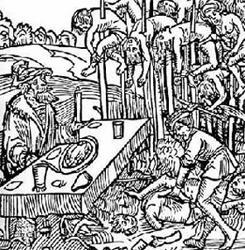

As his talent for torture and sadism became known, the name "Dracula" came to be interpreted more and more as the son of the Devil (instead of the originary the son of the Dragon). Because of the way he was punishing his enemies, Vlad Dracul got the nickname "Tepes". The Romanian word teap„ means impaler. The historians named him Vlad Tepes but he used to sign with his father's name, "Dracula". This is testified in the first documentary mentioning Bucharest (September 20, 1459) and in the portrait of Odhsenbach Stambuch (Stuttgart). |
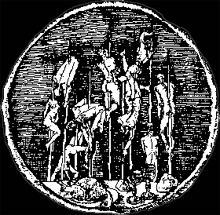 |

Towards the end of 1476 Vlad is killed at Snagov (by Basarab who followed him to the throne of Wallachia). According to the rumors, Vlad Tepes Dracula died violently, at the hands of one of his men who was actually an ottoman spy. He was burried at one of his monasteries (on the island at Snagov). Contrary to popular belief, Dracula's castle is not situated in Transylvania. The crumbling ruins still stand in the northern Wallachian town of TÓrgoviste (now central Romania).
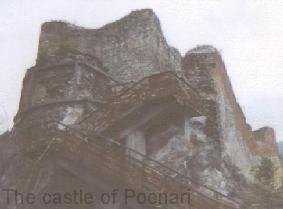

At first, when the ordinary people saw Vlad's father with the dragon symbol, they interpreted it as he was in league with the devil. Later, Vlad Tepes, nicknamed Dracula (the son of the dragon), was seen more and more as the son of the devil (because of his talent for torture). It seems that that the words devil and vampire are symilar in some languages, that's for the association of Vlad Tepes with vampirism. According to the story, Vlad used to bath in his enemies blood, to keep him young and strong. He's absence from his grave is also related to the vampire story. |  |

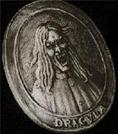 The stories regarding Vlad's cruelty circulated later throughout Europe. In the German region was published a first book in 1463 (The History of Voivode Dracula) and later republished in several editions. This was an obvious attack against Vlad (because of his policy regarding the Germans), that's why the stories where exagerated 'till the limits of the unbelievable. In the russian region circulated a manuscript version from 1468. The story was passed on to the peasants creating an incredible vast folklore. In the South-Eastern Europe, where no written version existed, the story passed on as an oral tradition. Later on several new stories were published, more and more far from the reality. This was the born of the vampire literature. After a long time of research, Bram Stoker published in 1897 the masterpiece of this style, "Dracula". This was the begining of an incredible explosion of literature and movies related to vampirism. The stories regarding Vlad's cruelty circulated later throughout Europe. In the German region was published a first book in 1463 (The History of Voivode Dracula) and later republished in several editions. This was an obvious attack against Vlad (because of his policy regarding the Germans), that's why the stories where exagerated 'till the limits of the unbelievable. In the russian region circulated a manuscript version from 1468. The story was passed on to the peasants creating an incredible vast folklore. In the South-Eastern Europe, where no written version existed, the story passed on as an oral tradition. Later on several new stories were published, more and more far from the reality. This was the born of the vampire literature. After a long time of research, Bram Stoker published in 1897 the masterpiece of this style, "Dracula". This was the begining of an incredible explosion of literature and movies related to vampirism.


Site Name: Arthur's Web
InterNet Location: http://www.mediaport.org/~arthur
Author: Arthur Schwimmer, (c) 1997
E-Mail Adress: arthur@mediaport.org
|


 The original Dracula is related to Vlad Dracul (1431 - 1476), beter known through history as Vlad Tepes (read Tsepesh). Vlad has ruled Wallachia (Tara Rom‚neasc„, now southern Romania) between 1456 and 1476.
The original Dracula is related to Vlad Dracul (1431 - 1476), beter known through history as Vlad Tepes (read Tsepesh). Vlad has ruled Wallachia (Tara Rom‚neasc„, now southern Romania) between 1456 and 1476.






